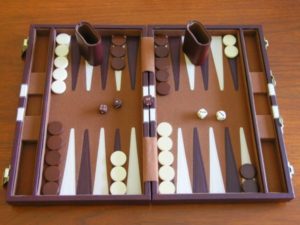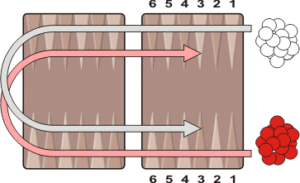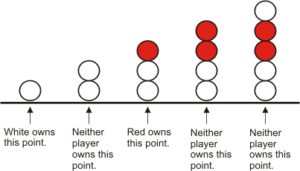The Blocking Game – Backgammon Variant

Setup: Each player starts with fifteen checkers off the board. The players enter their checkers in the opponent’s home board, then bring them around the board as shown in the diagram below.
Object: The object of the game is to move all of your checkers around the board to your own home table and then bear them off. The first player to bear off all of his checkers wins the game.
To start: Each player rolls one die and the higher number goes first. That player then rolls both dice again to begin his first turn.
Entering checkers: You enter a checker by placing it on a point in the opponent’s home board corresponding to a number rolled. For example, if you roll 6-3, then you enter one checker on the opponent’s six-point and one checker on his three-point. You must enter all of your checker before you can begin moving forward.
Owning a point: Any time you have exactly one checker on a point, you ownthe point and your opponent cannot land or touch down on that point. Thus a sequence of six consecutive single checkers constitutes a prime which the opponent cannot cross. If you have two or more checkers on a point, you no longer own the point and the opponent is free to move onto the point as he wishes.
There is no hitting in this game.

Movement: The roll of the dice indicates how many points, or pips, the player is to move his checkers. The following rules apply:
- The numbers on the two dice constitute separate moves. For example, if you roll 5 and 3, you may move one checker five spaces to an open point and another checker three spaces to an open point, or you may move the one checker a total of eight spaces to an open point, but only if the intermediate point (either three or five spaces from the starting point) is also open.
- Doubles are played twice. For example, a roll of 6-6 means you have four sixes to use.
- You must use both numbers of a roll if possible, or all four numbers in the case of doubles. If you can play one number but not both, you must play the higher one.

Last-in-first-out: Only the last checker to arrive on a point may move off the point. For example, if your opponent has two checkers on a point and you move one of your checkers onto that point, his checkers are trapped until you leave.
Bearing Off: Once you have moved all fifteen of your checkers into your home board, you may begin bearing off. You bear off a checker by rolling a number that corresponds to the point on which it resides, then removing the checker from the board.
If there is no checker on the point indicated by the roll, you must make a legal move using a checker on a higher-numbered point. If there are no checkers on higher-numbered points, you must remove a checker from the highest point that has a checker.
Scoring: The first player to bear off all of his checkers wins the game. Gammons and backgammons do not count extra.
The doubling cube is not used in Blocking Backgammon.
Blocking Express
Blocking Express is played the same as Blocking Backgammon except that when a player rolls doubles he plays those doubles and all the doubles above it. For example, if you roll 3-3, you play the 3-3, then 4-4, then 5-5, then 6-6.
Any time you can’t play all of your doubles, the opponent takes over, playing the numbers you could not. And if he also cannot finish, control returns to you. Play alternates back and forth as necessary until all the doubles have been played or until both players are stuck. This ends your turn, and now it is your opponent’s turn to roll the dice.